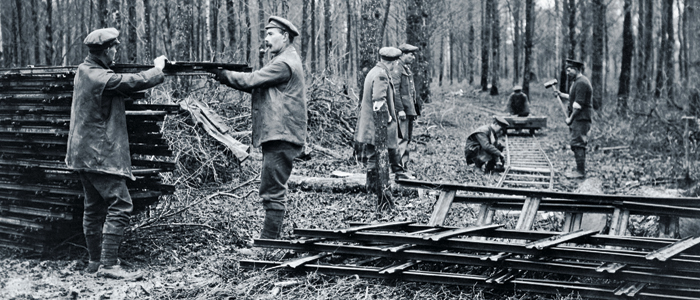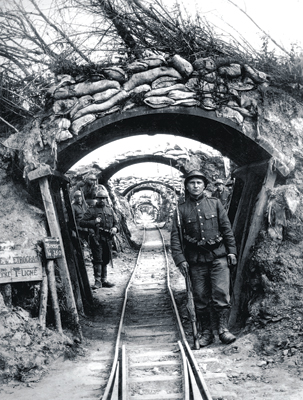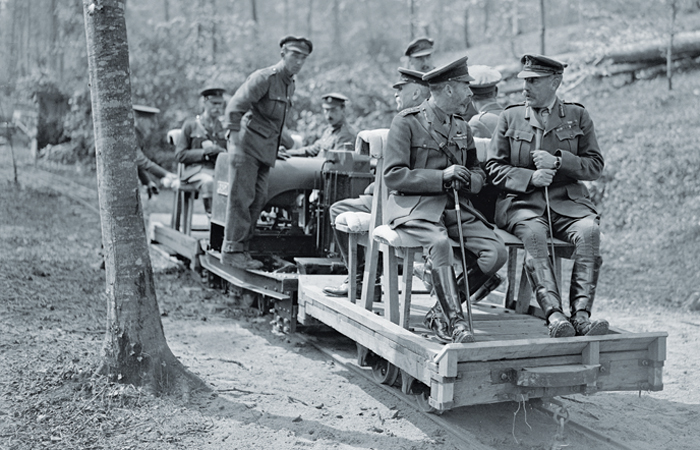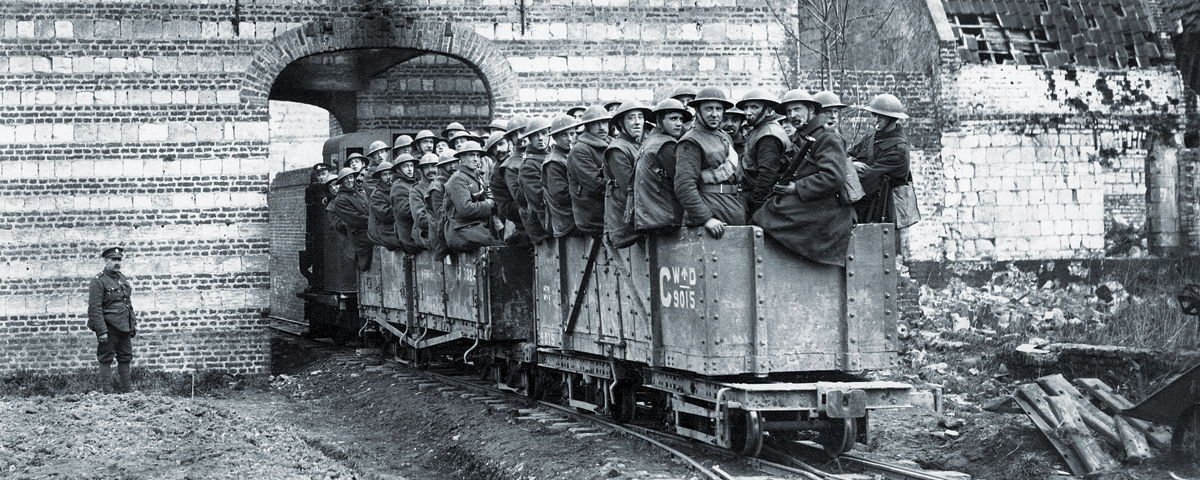American railroaders dubbed it “Dead Man’s Curve,” and it was certainly a dangerous place to drive a train. Though little more than a jug handle in the line near Beaumont village in the Meuse River valley of northeastern France, the wriggle lay within range of German artillery. From their aerie atop nearby Montsec eagle-eyed enemy observers watched for any sign of movement on the Woëvre Plain. The slightest Allied twitch would trigger a relentless barrage. But the troops in the trenches depended on regular supplies, so each day the railroaders risked their lives on the ribbon of line known as the soixante.
The narrow-gauge military railways of World War I looked like the kind of toy a rich man might run on his estate for the amusement of friends and family
The narrow-gauge military railways of World War I looked like the kind of toy a rich man might run on his estate for the amusement of friends and family. The gauge spanned 2 feet. The engines were tiny, the cars almost cute. But during the 1914–18 clash on the Western Front these little trains served a deadly serious purpose, hauling to the front the myriad materiel required to wage war: heavy-caliber ordnance, ammunition, poison gas, rations, medical supplies, fresh troops. Armies on either side of no-man’s-land had voracious appetites, and keeping them dependably supplied was a Herculean task, best accomplished by the Lilliputian trains that crisscrossed the front on thousands of miles of track. Operated by the British, French, Germans and, later, Americans, the light railways represented literal lifelines to the trenches.
Military railroads have been around since the Crimean War, when in 1855 British engineers built a 7-mile double-track line northward from the port of Balaklava to support the siege of Sevastopol. During the American Civil War the U.S. Military Railroad, a separate agency within the War Department, oversaw the movement of Union troops and supplies on captured Southern rail lines. Combatants in most of the late 19th century conflicts made extensive use of railroads, but those lines operated on standard gauge (4 feet, 8½ inches) track. Prewar military planners sought narrow-gauge lines that crews could quickly erect and move as the tactical situation dictated.
In the mid-1870s French civil engineer Paul Decauville invented just such a portable track system, initially intended for use on farms and industrial work sites. He chose a gauge of 60 cm—soixante, in French—3/8 inch shy of 2 feet. Key to his design were prefabricated track sections (think model train set) of varying lengths that one or two men could carry and place with minimal effort.

The Russian army was the first to see the military potential of narrow-gauge railroads. In 1880 Czar Alexander II’s war ministry purchased from Decauville 22,000 sections (about 64 miles) of track, several hundred freight cars and a pair of small steam locomotives, all for use in Turkistan. A year later the French army followed suit with an order for 41 miles of track. France purchased another 300 miles of track in 1888 to connect a string of forts along its border with Germany. For that deployment Decauville designed special carriages to transport 48-ton artillery pieces between the installations.
The German army began developing its own 60 cm Heeresfeldbahn (“Army Field Train”) in the mid-1880s. The Germans had a broader vision of how light railways could be used offensively. “The narrow gauge was conceived as a means of quickly producing a transport infrastructure which could follow the armies in the field as they advanced,” railroad historian Charles S. Small noted. In 1897 the German army deployed its Feldbahns (“field trains”) to German South-West Africa (present-day Namibia) to support its ongoing fight against insurrectionists, providing its railway brigades with an instructive real-world trial. Drawing on the experience, the Germans set about redesigning their equipment to meet the needs of a truly mobile rail system. The French gained their own practical experience constructing commercial 60 cm lines in Morocco.
The British were well behind their Continental counterparts in developing a narrow-gauge military rail system. Not until 1904 did the Royal Engineers build an experimental 2-foot-6-inch line (76.2 cm) at Longmoor Camp in Hampshire, mainly to instruct soldiers how to build and operate rail lines. But the service gave little thought as to how to apply this new means of transport in wartime. In fact, when it came to tactical transport, prewar British policy specified the use of trucks and buses.
Providing the motive power were chunky six- or eight-wheeled steam locomotives fired by smoky low-grade coal that made the little trains easy targets for enemy artillery and aircraft
Hostilities commenced in Europe on Aug. 5, 1914, when the Germans attacked Liège, Belgium. The medieval city fell 11 days later. By the 20th the attackers had occupied Brussels and begun a push toward Paris. In anticipation of supplying the fast-moving troops, Kaiser Wilhelm II’s planners had stockpiled Feldbahn track and rolling stock along the border. By August 22 the narrow-gauge trains were supporting three army corps on a network that soon spread across Flanders and Wallonia.
At the war’s outset France’s soixante resources were limited to permanent installations, though the government had set aside some portable track and cars in case of war. It quickly sent those to Belgium. The British army, adhering to its prewar transport policy, immediately pressed into service 1,000 civilian trucks, 300 buses and tens of thousands of horses.
By mid-September 1914 the “war of movement” had devolved into a stalemate, giving rise to static trench warfare. The resourceful Germans were quick to repurpose their Feldbahns to directly serve frontline sectors. The French followed suit and soon had a considerable narrow-gauge network in place. The British continued to eschew light rail service until February 1916 when the army high command, recognizing the shortcomings of road transport on the muddy front, belatedly ordered the development of tactical narrow-gauge lines. By then domestic factories were so overburdened that Britain was forced to order much of its 60 cm railroad equipment from the ostensibly neutral United States. Within a year Britain’s light railways were hauling more than 200,000 tons of supplies each week.
The entry of the U.S. into the war in April 1917 brought a new spirit and vigor to Allied military railway operations.
The first Army Corps of Engineers light railway unit, the 12th Engineer Regiment, mobilized in June 1917 with a complement of 1,600 officers and men recruited from among experienced railroaders and engineering professionals. The regiment arrived in France’s Somme region in late August. Three months later the rookie railwaymen were stunned when sucked into the Battle of Cambrai, a tactical draw between British and German forces best remembered for the first massed attack by a new weapon known as the tank. On November 30 the trainmen, all noncombatants, were nearly overrun when the Germans tried to capture the soixante during a counteroffensive. “Thus it was,” notes the regimental history, “that the first Americans fought in the world war. Caught without arms, they fought with whatever they had at hand.” In their case that meant clubs, picks, shovels and any weapon they might recover from fallen friends or foes.
The U.S. 21st Engineer Regiment (Light Railway), organized in August 1917, comprised two battalions—one for construction and maintenance, the other to operate the 60 cm lines. The regiment shipped out for France in December and on arrival deployed to the Lorraine region of northeastern France, in the open countryside between Verdun and Nancy.
In cooperation with the French National Railway the 21st first built a massive depot and rail yard at Sorcy-Saint-Martin, just 11 miles from the trenches. The U.S. railroaders then set about reorganizing the soixante to meet their requirements, building new lines and rebuilding large sections of track with more substantial roadbed and heavier rails. The flow of narrow-gauge equipment seemed endless, as Allied ships transported hundreds of locomotives and thousands of railcars across the Atlantic. In late March 1918 the French army officially handed off its narrow-gauge operations in the area to the Americans.

A typical soixante line on the Western Front centered on a terminus, like Sorcy, well behind the front lines and outside the range of most enemy artillery. There standard-gauge trains off-loaded supplies for transfer to the narrow-gauge trains, whose branch lines radiated out to forward sectors. Within the terminus was a workshop for the repair and maintenance of rolling stock.
Providing the motive power were chunky six- or eight-wheeled steam locomotives fired by smoky low-grade coal that made the little trains easy targets for enemy artillery and aircraft. To reduce the risk of detection, railroaders used gasoline-powered rail-tractors to pull cars the last mile or so to supply dumps. The rolling stock comprised mostly boxcars, gondolas and flatcars with a capacity of 22,000 pounds. As the war progressed, the Allies introduced special cars to haul huge 120 mm and 240 mm guns, as well as U.S.-designed 2,000-gallon tankers to tote fresh water to the troops. The British and Germans also pioneered the use of light railways to evacuate wounded soldiers. Once a train arrived at its destination and offloaded its cargo, crews quickly fitted the empty cars with racks to support stretchers. With the wounded aboard, the train ran directly to rear-area casualty clearing stations, ensuring the men received medical care hours earlier than had they been transported by road.
Manpower on the U.S. lines included both seasoned professionals and raw recruits. It was not unusual for locomotive engineers to be in their 30s or 40s, while dispatchers—so critical to the smooth operation of the lines—boasted years of experience. By necessity the civil engineers laying out the lines, bridges and tunnels were professionals. But any grunt work—digging, hauling, grading, laying and repairing track—was left to the young and fit.
Because the demand for supplies was unrelenting—a 12,000-man division, for example, required an estimated 1,000 tons of supplies daily—the light railways ran both scheduled and ad hoc service. The first few miles to the front were almost pleasant, pastoral outings, as the trains streamed through dense forestland and traversed rolling countryside past fields and farms barely touched by the war. But on the approach to the battlefields the woods were devoid of trees, the fields pockmarked with craters, the farmhouses in ruins.
The trains were at greatest risk when crossing open country, especially in daylight. As Private Leland McCrady of the 21st Engineers recalled, “German observers in balloons and observation posts on Montsec kept lookout for signs of steamers or tractors operating throughout these points and were ever ready to shell us.” To camouflage the rails in especially vulnerable spots like Deadman’s Curve, the Allies strung tall screens comprising woven branches or burlap strips along the roadbed. Whenever possible the trains made their runs under cover of darkness. But even that was no guarantee of success. “German planes,” McCrady recalled, “[were] always on the lookout for sparks from the steamer and quick to turn their machine guns on them or to drop bombs.” Aircrews also dropped parachute flares, which illuminated large swaths of the battlefield for long minutes, enabling artillery spotters to pinpoint the trains. Though fired on often, the diminutive trains rarely suffered a direct hit.
‘It is about as impracticable to destroy such a railway by shell fire,’ wrote civil engineer Marshall R. Pugh, ‘as it is to get rid of cooties in the same manner’
The soixante lines terminated anywhere from a few hundred to a few dozen yards from the trenches. From there goods and munitions moved forward by manpower or horsepower, sometimes on 40 cm tramways running through the trenches. Shells went straight to concealed ammunition dumps, while the daily train of rations trundled farther forward to frontline mess kitchens.
Derailments and accidents were all too common occurrences. “The engineer simply had to trust in Providence not to tip over, hit a cannon, a column of squads, some wooden-shoed women or a French general,” quipped 21st Engineers Sergeant Clarence P. Hobert in the official unit history. The hazards were magnified at night. “[One] night,” Hobert recalled, “a French truck loaded with gasoline rammed into an ammunition train, causing an explosion, the flames lighting the skies for miles around. Many gas shells exploded, and the men were obliged to wear their gas masks and lie in a muddy ditch for some time.”
In a similar incident the situation was reversed: The train hauled a pair of tankers full of gasoline, the French truck munitions. Slipping over a hill in the dark, the locomotive smashed into the truck, hurling it aside and setting it on fire. The engineer called for brakes, and as luck would have it, the tankers rolled to a stop adjacent to the burning vehicle. It was another recipe for disaster. One of the brakemen, Private Sanford C. Johnson, saw that the driver was pinned beneath his truck. He and a fellow crewman ran to the stricken man but couldn’t budge him. “We were under the truck, working like mad,” Johnson explained, “when the truck blew up. The jar evidently lifted the weight from our comrade, as we freed him.” As the crewmen ran for cover, dragging the Frenchman between them, the 75 mm shells began cooking off. “[They] were coming thick and fast from the camion,” he recalled. “As we were straightening to carry the wounded man, a huge explosion threw us all on our faces.” The tankers had blown. The resulting conflagration destroyed four railway cars and three French ammunition trucks. When the fire died down, bystanders found the charred remains of a French soldier. “The fire and explosion caused considerable excitement,” Johnson noted laconically.
The lightweight rails were often in lamentable condition, but one great advantage of the soixante was the ease with which it could be repaired. If intense shelling took out a couple hundred feet of track, repair crews got straight to work, first filling the craters, then connecting new sections of Decauville rails to the undamaged line. “‘Dead Man’s Curve’ was subjected to shelling for months, but comparatively infrequent repairs to the track were necessary,” wrote civil engineer Marshall R. Pugh after the war. “It is about as impracticable to destroy such a railway by shell fire as it is to get rid of cooties in the same manner. This fact is their protection.”
Whenever either side planned a great offensive seeking to gain or regain territory, the railway engineers began stockpiling track, ballast and tools near the front to facilitate the rapid construction of a link with the enemy’s 60 cm rail network. After the breakout, as soon as commanders were certain the assault had succeeded and positions were consolidated, rail crews commenced laying track across no-man’s-land—a process that took only a day or two before the trains were up and running. Any captured enemy rail equipment was put to use on the victor’s lines. Of course, sometimes the enemy pushed back, overrunning the newly gained territory and taking back their railroad.
Conditions at the front were tough on the narrow-gauge crews. “We were under shellfire every night,” reported Lieutenant O.C. Whitaker of the 21st Engineers. “It was no uncommon thing for one to spend the better part of the night with his gas mask in the alert position, his teeth chattering and his knees knocking together.” Despite the dangers, casualties were relatively light. Thirty-six men from the 21st died while on duty in France. That’s not to say operating the soixante was a milk run. Far from it.

On Armistice Day, Nov. 11, 1918, the U.S. Corps of Engineers controlled some 1,350 miles of narrow-gauge railways in France, more than half of which had been captured from the Germans. By the time the rail service wound down at the end of January 1919, U.S. trains had transported more than 860,000 tons of supplies to the front, those of the British and Germans millions of tons more.
The war proved the zenith of military light railways. The indispensable contribution they made was due largely to the static nature of trench warfare, for which soixante operations were uniquely qualified. But narrow-gauge railroads never again played a significant role in war. Colonel William B. Parsons wrote a fitting tribute in his official history The American Engineers in France: “In short, the Lilliputian railway that at the beginning of hostilities was little more than a toy with apparently limited possibilities had grown into a very husky system.” The tiny trains were a vital part of the supply system. It is difficult to see how the armies could have functioned without them. MH
Steven Trent Smith is a five-time Emmy Award-winning television photojournalist and author of two books, The Rescue and Wolf Pack, about the submarine war in the Pacific. He is a frequent contributor to World War II, MHQ: The Quarterly Journal of Military History and Civil War Times. For further reading Smith recommends Narrow Gauge to No Man’s Land, by Richard Dunn; Two-Foot Rails to the Front, by Charles S. Small; and Railways and War Before 1918, by Denis Bishop and W.J.K. Davies.





